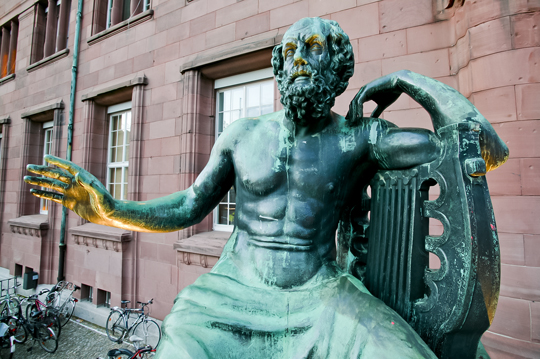Changing Narrative Forms
Freiburg, Aug 02, 2019
Anyone who has studied literature knows that narratology has always been shaped by its structuralist beginnings: Until now, narrative research has followed in the tradition of the French literature scholar Gérard Genette, and is a synchronous discipline with a claim to the unity of its categories – this includes, for example, narrative perspectives. Freiburg English scholar Prof. Dr. Monika Fludernik wants to expand the current model. She is the first literature scholar in Germany to have attracted funding of a million euros from the German Research Foundation (DFG) for a Reinhart Koselleck project. With her ‘Diachronous Narratology’ project, Fludernik not only wants to smooth the way for historical findings in narrative research, taking English literature as its example, but also to open up narratology to a cross-epoch – that is, diachronous – perception.

Telling stories is a fundamental form of human communication – in literature its counterpart is the epic. Photo: Africa Studio/stock.adobe.com
Narrative is an elementary form of human communication. In literature its counterpart is the epic. Everyone tells a story – whether it is full-length, such as those by Homer, the reportedly blind rhapsodist and founding father of western literature, or whether it is in the short form of an anecdote, like those recorded by Heinrich von Kleist. An even shorter version are the jokes that Joe Bloggs makes every day. And it is known in psychology that simply retelling the tale of a conflict-ridden situation can help the emotional healing process.
With its academic foundations in the 1950s, from the start narrative theory placed the focus on codifying elements such as narrative time or narrative perspective. At the same time, it paid attention to a comparative consideration of literature in a synchronous cross-section. However, this lost sight of historically differing forms of narrative. Now, Monika Fludernik wants to fix this blind spot in narrative theory.
A huge historic arc
Her project has two goals. On the one hand, a study will compare developments in narrative in various genres. This will study texts from the late Middle Ages and the early modern era up to the 18th century. Secondly, Fludernik wants to span a large arc from the late Middle Ages to the 19th century in a monograph and analyze the change in narrative forms, drawing on both theoretical and methodical reflections. “I’m an English scholar, but I also want to include German and French texts,” she says. “Above all, however, using the example of English literature, I want to examine thoroughly how a diachronous consideration of narrative literature might look.” She plans to carry out part of this work over several sabbatical semesters. Conferences and guest professorships are also planned.

The man with the lyre: Homer is seen as the forefather of western literature. Photo: Michael Spiegelhalter
Fludernik’s approach is above all linguistic. “For instance, it’s about the frequency of pronouns in texts or the use of a specific tense.” At the same time, historic findings will also play a part, “For example when there’s a shift from one text form to another, it’s worth asking why,” she says. “The Stuarts, for example, after their restoration in England, brought their experiences at the French court to London: such as the model of classic French theater or the freedom for women to appear as actresses.” Influences like these can also appear in prose texts. For example, the heroic French novel was suddenly important in England too.
Legends of the saints and romances
So does she already have working hypotheses? During her preparatory work, Fludernik has already noticed some breaks in text elements, which have retained the form, but changed function. As an example, she names the incidence scheme. Originally its role was to introduce an unexpected change in the middle of a narrative episode. “With the change in narrative forms to the novel, it lost this function, but it didn’t simply disappear, instead, it recurs at the start of larger narrative units such as a new chapter, if possible connected with a change of location, as an introduction to the next major unity of action.” In addition, Fludernik has observed that narrative elements that were preserved in the legends of the saints into the 15th century, had already disappeared in romances in the 14th century. She wants to pay special attention on such variants of asynchronous change of narrative forms, “One genre paves the way, others follow.”
The influence of the change is finally also the central point of reference to the namesake of the project, whose work Monika Fludernik “treasures extraordinarily”: the famous historian Reinhart Koselleck researched how terms changed over time.
Hans-Dieter Fronz

